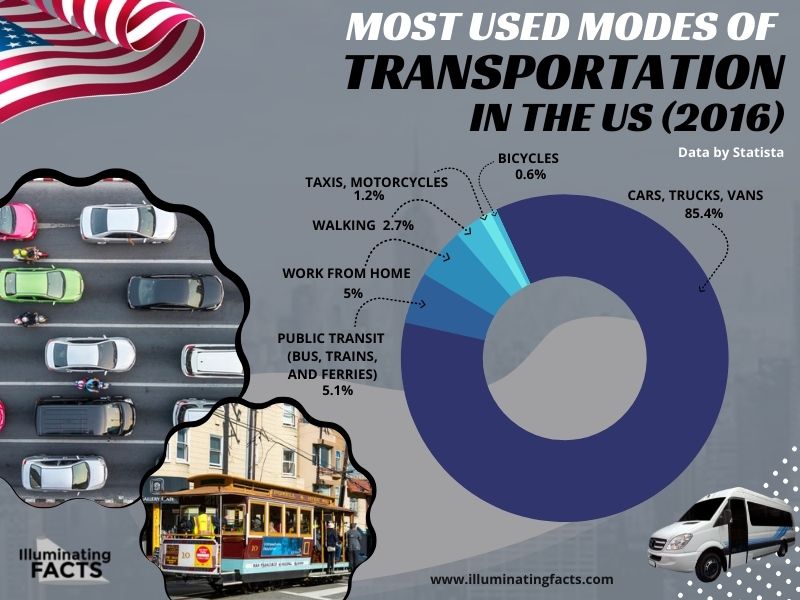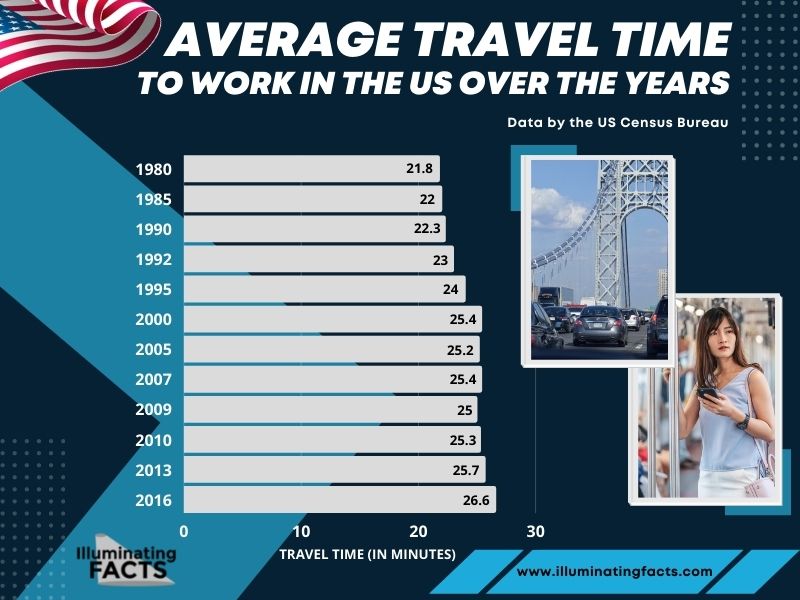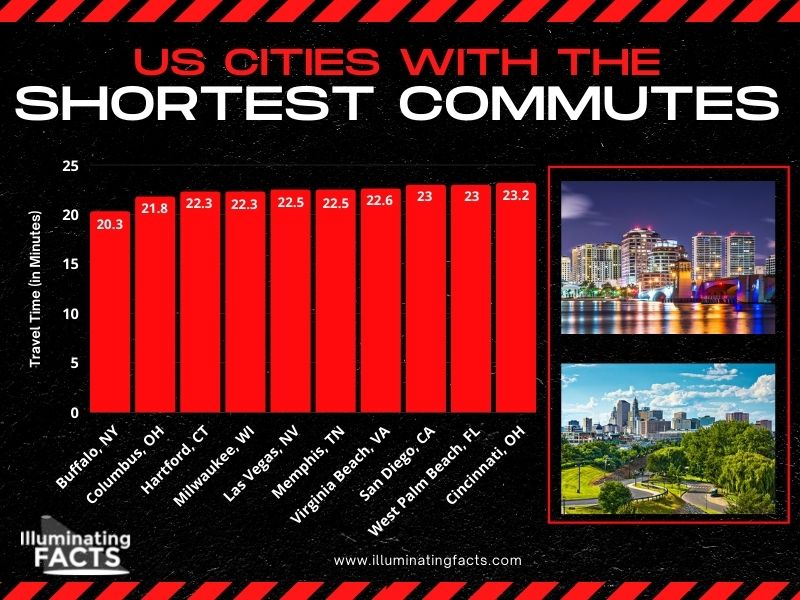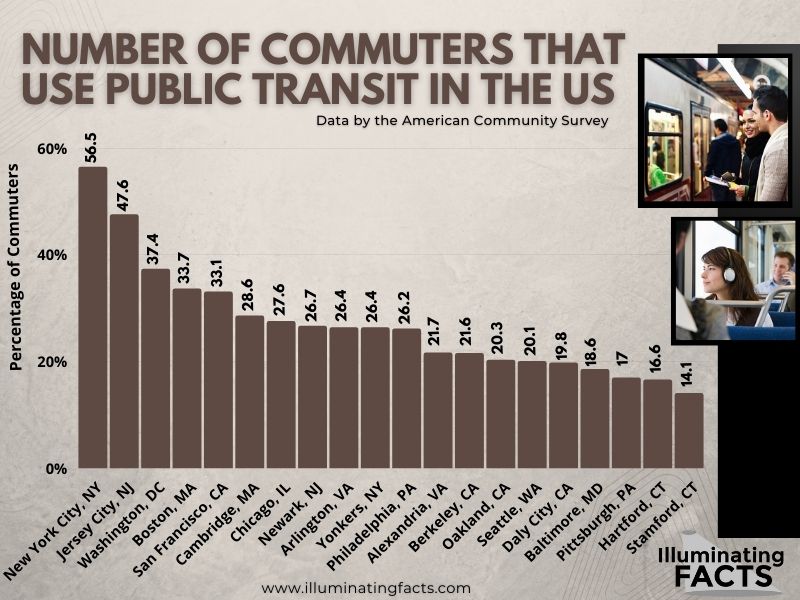As of 2020, the USA has become home to over 359 million people. Having such a high population, different types of facilities such as proper transport and commute are required to ensure that the citizens do not face any problems. To accommodate these 359 million people, the US has invested in various forms of commuting such as taxis, trains, ride-share services, subways, air travel, road network, and several others as well. We can evaluate American commuting with the help of the following graphs.
Find Out More…
Most Used Modes of Transportation in the US as of 2016
The US is a developed country where there are many automobile manufacturers as well. The citizens earn well and the car manufacturers are often able to produce cars in a mid-price range as well. This is why cars, vans, and trucks account for 85.4% of transportation in the US. While this data is from 2016, the numbers are pretty much the same even today. The second most used mode of transportation in the US has been public transit which includes buses, subways, trains, etc. This sector has 5.1% of the transportation in the US. 1.2% of people have either a taxi or a motorcycle for commuting. An increasing number of work-from-home people means that limited transport is being used by them. 2.7% of people prefer walking while 0.6% are good to go with a bicycle.
Average Commute Time in the US as of 2021
Due to the wide range of transport facilities present in the US, the average commute time is quite less. The road networks are excellent while the public transit is also operated on a mass scale with minimum delays. As a result, 24% of people in the US have an average commute time of fewer than 15 minutes. 30% of citizens in the US commute between 15 and 29 minutes. 17% of people said that it takes them 30 minutes to an hour to commute. 4% said that it takes them somewhere between an hour and 2 hours while 1% have more than 2 hours of commute time. Surprisingly, 25% work from home and have no commute time.
Travel Time to Work For Each State in the US (2019)
We can infer that the majority of the population of the US has access to easy and convenient commuting facilities which is why they can travel in less time. This is further clarified with the graph that shows the time required for people to travel to work in multiple states. Even at most, it takes about 33 minutes to travel to work. This is the case in New York City. All other states have lesser travel time but somewhere close enough. The minimum time required for traveling to work has been seen in Colorado where it takes 25.8 minutes only. We can see that the maximum and minimum times only have a difference of about 8 minutes.
Average Travel Time to Work in the US Over the Years
The US has been a developed economy for a long time. The governments have actively focused on road networks and commuting facilities since the 1980s. However, due to an increase in population, there has been a slight increase in the average travel time over the past few decades. In 1980, the average travel time to work was 21.8 minutes and reached 25.4 minutes in 2000. Since then, there has been improvement in the travel facilities and networks which is why the time has not fluctuated much. As of 2016, there was only an increase of 1.2 minutes from 2000 and the average travel time to work reached 26.6 minutes.
US Cities With the Longest Commutes as of 2021
Despite the fact that there has been improvement in traveling networks, some cities still have a longer time than others mostly because of high population and easy access to private cars causing rush and traffic jams. New York City is on top of this list with 34.7 minutes of commute time. This is also because the city is too big and the places are quite far away. Washington has 32.8 minutes of commute time while Newark has 31.1 minutes of commute time. Other cities with the longest commutes as of 2021 include Chicago, Boston, Oakland, Baltimore, and Atlanta.
US Cities with Shortest Commutes as of 2021
While some cities of the US may have more than 25 minutes of commute time, there are a few which have the lesser time required for commuting as well. Buffalo, NY is on top of this list where the commute time is only 20.3 minutes. Columbus, OH has a commute time of 21.8 minutes. Milwaukee, WI, and Hartford, CT come at third with 22.3 minutes of commute time. Las Vegas, NV, and Memphis, TN also have an equal commute time of 22.5 minutes each. San Diego, CA, and West Palm Beach, FL have a commute time of 23 minutes each. Last on the list of US Cities with Shortest commute as of 2021 is Cincinnati, OH with 23.2 minutes of commute time.
Number of Commuters that Use Public Transit in the US
The American Community Survey has provided the data to evaluate the number of commuters who are depending upon public transport services in the US. There is a high trend of it because of the longer distances, increasing fuel costs for personal cars, and easier accessibility as well. 56.5% of people in New York City use public transit services which is more than half the population of the entire city. Jersey City is also close with 47.6% of commuters using public transit. Washington DC and Boston have 37.4% and 33.7% of commuters traveling via public transit. In most cities, more than 20% of commuters have been seen using public transit services in the US.




.jpg)



